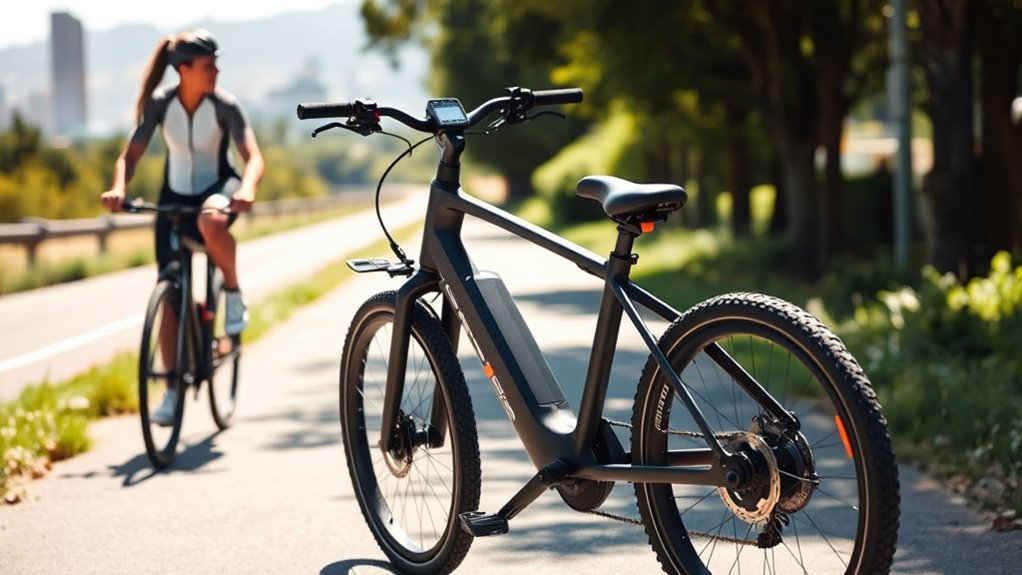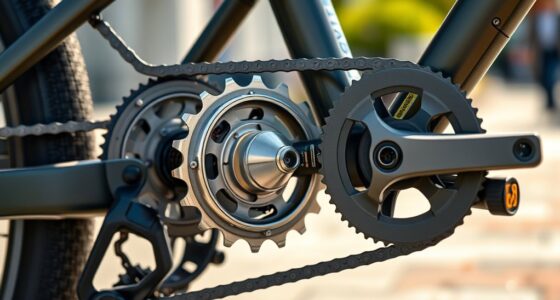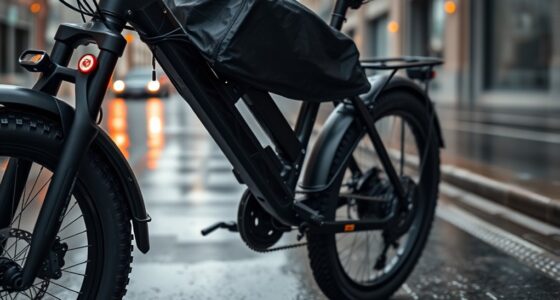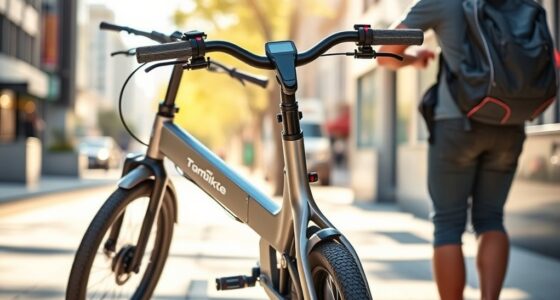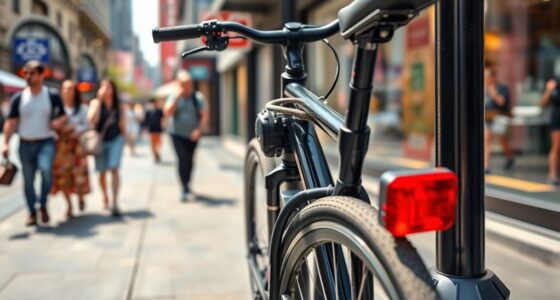Finding the right balance between weight and range for portable e-bikes means choosing a model that’s easy to carry without sacrificing too much distance. Lighter bikes are easier to transport but may have limited range, while heavier bikes often hold more battery capacity and travel further. The key is identifying your typical riding needs and preferences. Keep exploring to discover how to find a bike that fits both your portability and mileage expectations seamlessly.
Key Takeaways
- Lighter batteries improve portability but may limit overall riding range.
- Higher efficiency batteries extend distance but often add weight to the bike.
- Folding mechanisms that are simple and lightweight enhance portability without sacrificing range.
- Balancing bike weight and battery capacity is essential for meeting individual riding habits.
- Advances in battery tech aim to optimize both weight reduction and increased range simultaneously.
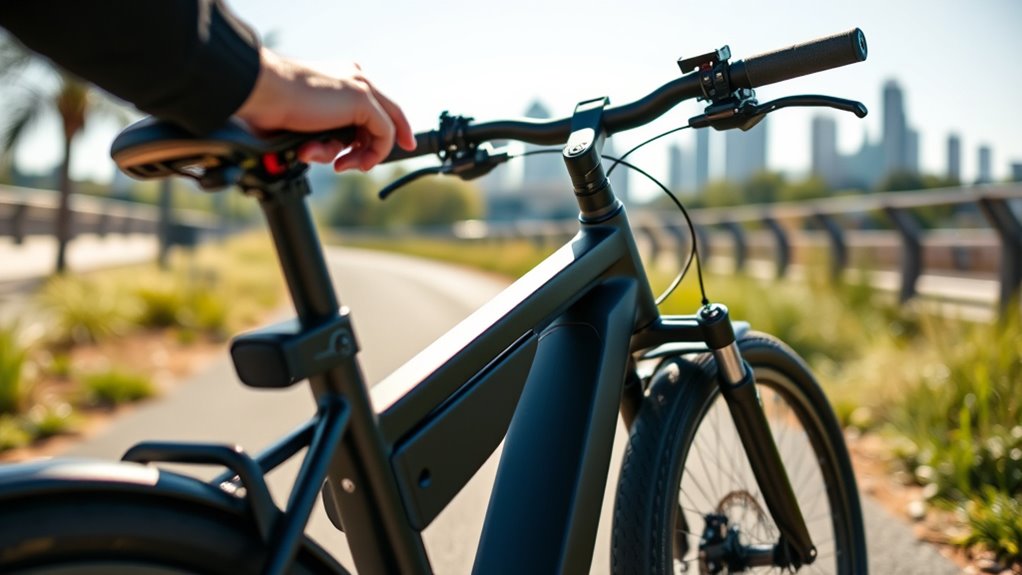
When choosing a portable e-bike, understanding the trade-off between weight and range is essential. You want a bike that’s easy to carry but still offers enough distance for your rides. The key lies in balancing battery efficiency and design features like folding mechanisms. Battery efficiency directly affects how far you can go on a single charge. A more efficient battery consumes less power while providing a longer range, but these batteries often add weight. Conversely, lightweight batteries may save weight but could limit your distance. Finding the right battery balance depends on your riding habits. If you mostly ride short distances, a lighter battery with moderate range might work best. For longer commutes or adventures, investing in a more efficient, slightly heavier battery could be worth it.
Balancing battery efficiency and design features like folding mechanisms is key to a portable e-bike’s weight and range.
Additionally, battery technology continues to advance, offering lighter options with higher capacities, which could shift the balance in favor of longer-range, lightweight bikes in the future. Folding mechanisms also play a significant role in this balance. Bikes with simple, compact folding mechanisms tend to be lighter and easier to carry, making them ideal for last-mile commutes or storage in small spaces. However, some folding designs add extra components or thicker frames, which can increase weight and reduce portability. When choosing a folding e-bike, consider how often you’ll need to fold and carry it. If you plan to frequently switch between riding and transport, a bike with a quick, easy folding system is more practical. Keep in mind that some folding mechanisms might compromise battery placement or size, potentially impacting range. You’ll need to decide whether convenience or maximum range is your priority.
The weight of the bike also influences battery efficiency. Heavier bikes require more energy to move, which can drain your battery faster, reducing overall range. Lightweight frames and components help extend your ride, especially if the battery is on the smaller side. However, ultra-light bikes often sacrifice some durability or battery capacity to cut down on weight. So, if you’re considering a super-light model, check how that affects your riding distance and whether the battery’s efficiency can compensate for the lighter frame. It’s about finding a balance: a bike that’s not too heavy to carry comfortably but still offers enough range for your needs.
Ultimately, your ideal portable e-bike combines a reasonable weight with a battery system optimized for your typical riding distances. Folding mechanisms should enhance portability without adding unnecessary weight or compromising battery placement. By understanding these factors, you can select a bike that fits your lifestyle—light enough to carry easily, with sufficient range to keep you on the road longer. It’s a matter of prioritizing your riding habits and choosing components that work together to strike that perfect balance between weight and range.
Frequently Asked Questions
How Does Terrain Affect E-Bike Weight and Range?
Terrain greatly impacts your e-bike’s weight and range. Uphill or rough terrain forces the motor to work harder, reducing efficiency and draining the battery faster, even if your bike’s weight stays the same. You’ll notice a shorter range because the motor consumes more energy, especially if your bike has a lower battery capacity or less motor efficiency. To optimize performance, choose terrain-appropriate settings and make certain your e-bike has a high-quality battery and motor.
Can Additional Accessories Impact the Weight-Range Balance?
Yes, additional accessories can impact your e-bike’s weight-range balance. Accessory weight adds to the overall bike weight, making it harder to pedal and potentially reducing range. However, if you choose accessories that don’t substantially increase weight and guarantee your battery capacity is sufficient, you can enjoy enhanced functionality without sacrificing too much range. Always consider how each accessory affects the total weight and your bike’s battery capacity to maintain ideal performance.
What Maintenance Tips Optimize Battery Life and Range?
Think of your e-bike’s battery like a garden that needs regular tending. To optimize battery life and range, perform proper battery maintenance by avoiding full discharges and keeping it charged between 20-80%. Limit charge cycles by unplugging once fully charged, and store the bike in a cool, dry place. These habits help extend battery lifespan, ensuring your e-bike stays reliable and efficient on every ride.
Are Lighter E-Bikes Less Durable or Reliable?
Lighter e-bikes aren’t necessarily less durable or reliable. They often feature advanced frame materials like aluminum or carbon fiber, which maintain strength while reducing weight. Additionally, with a good battery capacity, lighter bikes can still deliver impressive range and dependability. Just make certain you choose models with quality components and proper maintenance, so the reduced weight doesn’t compromise durability or overall performance.
How Does Rider Weight Influence E-Bike Performance?
Your rider weight can dramatically influence e-bike performance, like a gust of wind shifting a sailboat. Heavier riders put more strain on the motor and battery, which can reduce range and acceleration. Conversely, lighter riders may experience smoother rides and longer battery life. To optimize your e-bike experience, consider your weight when choosing a model, ensuring it’s built to handle your load without sacrificing power or efficiency.
Conclusion
Sure, a lighter e-bike might seem ideal, but don’t forget, sacrificing too much weight can limit your range. Finding the sweet spot means balancing both—so you get portability without sacrificing distance. You might worry about durability, but modern materials make lightweight bikes just as tough. Ultimately, choosing the right weight-range combo keeps your ride enjoyable and practical, whether you’re commuting or exploring. Don’t settle for less—find your perfect balance and enjoy every mile.
